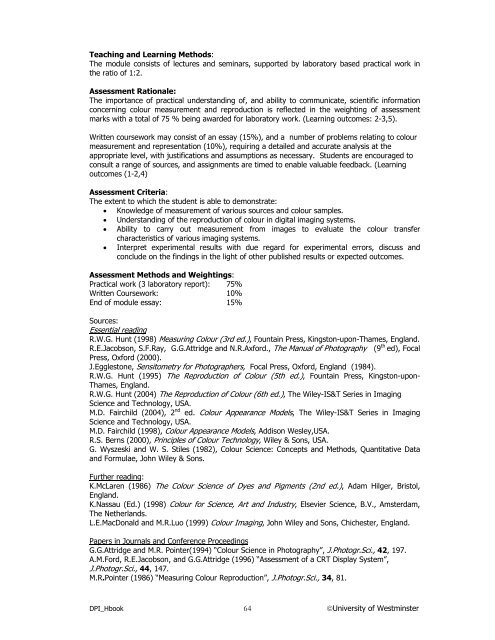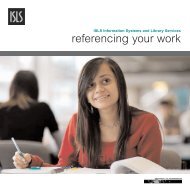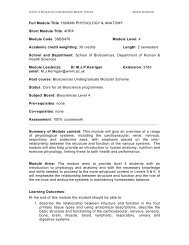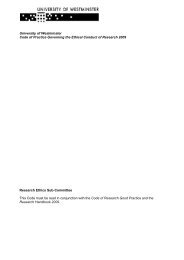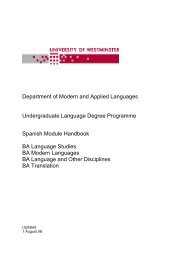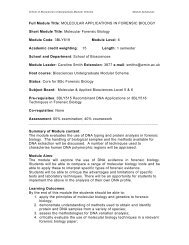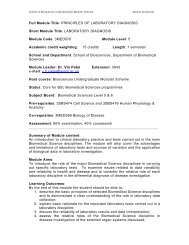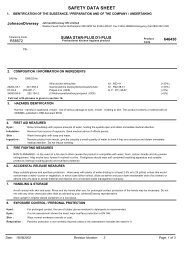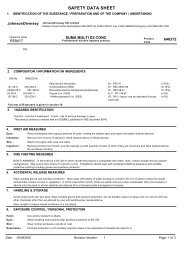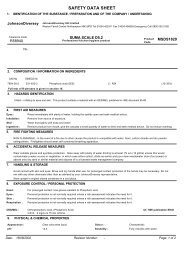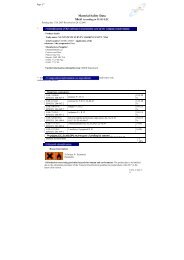CONTENTS 1. Introduction 1.1 Course Outline 1 1.2 Introduction ...
CONTENTS 1. Introduction 1.1 Course Outline 1 1.2 Introduction ...
CONTENTS 1. Introduction 1.1 Course Outline 1 1.2 Introduction ...
Create successful ePaper yourself
Turn your PDF publications into a flip-book with our unique Google optimized e-Paper software.
Teaching and Learning Methods:<br />
The module consists of lectures and seminars, supported by laboratory based practical work in<br />
the ratio of 1:2.<br />
Assessment Rationale:<br />
The importance of practical understanding of, and ability to communicate, scientific information<br />
concerning colour measurement and reproduction is reflected in the weighting of assessment<br />
marks with a total of 75 % being awarded for laboratory work. (Learning outcomes: 2-3,5).<br />
Written coursework may consist of an essay (15%), and a number of problems relating to colour<br />
measurement and representation (10%), requiring a detailed and accurate analysis at the<br />
appropriate level, with justifications and assumptions as necessary. Students are encouraged to<br />
consult a range of sources, and assignments are timed to enable valuable feedback. (Learning<br />
outcomes (1-2,4)<br />
Assessment Criteria:<br />
The extent to which the student is able to demonstrate:<br />
• Knowledge of measurement of various sources and colour samples.<br />
• Understanding of the reproduction of colour in digital imaging systems.<br />
• Ability to carry out measurement from images to evaluate the colour transfer<br />
characteristics of various imaging systems.<br />
• Interpret experimental results with due regard for experimental errors, discuss and<br />
conclude on the findings in the light of other published results or expected outcomes.<br />
Assessment Methods and Weightings:<br />
Practical work (3 laboratory report): 75%<br />
Written <strong>Course</strong>work: 10%<br />
End of module essay: 15%<br />
Sources:<br />
Essential reading<br />
R.W.G. Hunt (1998) Measuring Colour (3rd ed.), Fountain Press, Kingston-upon-Thames, England.<br />
R.E.Jacobson, S.F.Ray, G.G.Attridge and N.R.Axford., The Manual of Photography (9 th ed), Focal<br />
Press, Oxford (2000).<br />
J.Egglestone, Sensitometry for Photographers, Focal Press, Oxford, England (1984).<br />
R.W.G. Hunt (1995) The Reproduction of Colour (5th ed.), Fountain Press, Kingston-upon-<br />
Thames, England.<br />
R.W.G. Hunt (2004) The Reproduction of Colour (6th ed.), The Wiley-IS&T Series in Imaging<br />
Science and Technology, USA.<br />
M.D. Fairchild (2004), 2 nd ed. Colour Appearance Models, The Wiley-IS&T Series in Imaging<br />
Science and Technology, USA.<br />
M.D. Fairchild (1998), Colour Appearance Models, Addison Wesley,USA.<br />
R.S. Berns (2000), Principles of Colour Technology, Wiley & Sons, USA.<br />
G. Wyszeski and W. S. Stiles (1982), Colour Science: Concepts and Methods, Quantitative Data<br />
and Formulae, John Wiley & Sons.<br />
Further reading:<br />
K.McLaren (1986) The Colour Science of Dyes and Pigments (2nd ed.), Adam Hilger, Bristol,<br />
England.<br />
K.Nassau (Ed.) (1998) Colour for Science, Art and Industry, Elsevier Science, B.V., Amsterdam,<br />
The Netherlands.<br />
L.E.MacDonald and M.R.Luo (1999) Colour Imaging, John Wiley and Sons, Chichester, England.<br />
Papers in Journals and Conference Proceedings<br />
G.G.Attridge and M.R. Pointer(1994) “Colour Science in Photography”, J.Photogr.Sci., 42, 197.<br />
A.M.Ford, R.E.Jacobson, and G.G.Attridge (1996) “Assessment of a CRT Display System”,<br />
J.Photogr.Sci., 44, 147.<br />
M.R.Pointer (1986) “Measuring Colour Reproduction”, J.Photogr.Sci., 34, 8<strong>1.</strong><br />
DPI_Hbook 64 ©University of Westminster


